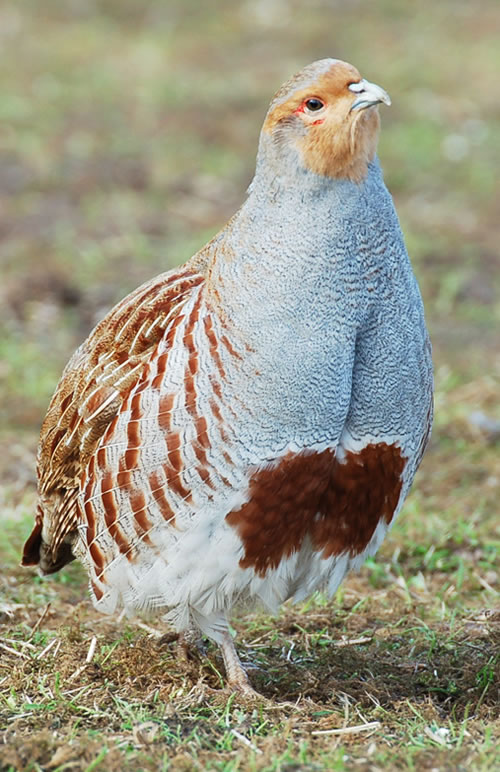
The launch of ground-breaking new guidelines by the Game & Wildlife Conservation Trust, which have been applauded by the Sustainable Use Specialist Group of the International Union for Conservation of Nature (IUCN), could mean that one of our most seriously threatened farmland birds is once again a common feature of the British countryside.
Since the advent of modern, intensive farming, particularly the introduction of herbicides and insecticides, which remove the insects that young chicks depend on when they first hatch, wild grey partridges have fared badly. Suffering a massive 80% decline in the last 40 years, grey partridges, together with many other farmland birds, have become part of a long list of casualties, and worse, the once familiar grey partridge is now locally extinct in many areas of the country.
But leading wildlife research charity, the Game & Wildlife Conservation Trust has, over the past 40 years, identified the reasons behind the decline and devised many effective techniques for reversing this decline.
The final link in this mammoth research effort to save this iconic species was unveiled at the CLA Game Fair at Blenheim Palace on Friday 25th July. Scientists from the Trust hope that their cutting-edge re-establishment recommendations, based on three-years of scientific research, will help to restore the bird in many areas of the country where it has become locally extinct.
Dr Nick Sotherton, Director of Research with the Game & Wildlife Conservation Trust (GWCT) explains, "These re-establishment guidelines are the culmination of three-years of intensive research and are the final piece in the puzzle to manage their recovery. With increasing urgency to deliver the Government's Biodiversity Action Plan target for grey partridges, we can now show how to put them back where they have disappeared. But this is no easy fix. To re-establish a wild population based on these guidelines depends on a lot of hard work together with a big investment in time."
These new guidelines are in-line with internationally accepted procedures for re-introductions produced by the International Union for Conservation of Nature (IUCN). Prof. Robert Kenward, Chair for Europe of the Sustainable Use Specialist Group (Europe) of IUCN-SSC said, "I was greatly impressed by the GWCT re-establishment guidelines. By combining an enormous volume of research into straightforward guidelines for the grey partridge, the GWCT has set a precedent in simplification for others to follow. We badly need such condensations of information to encourage effective restoration of species that have often been lost unwittingly. Otherwise, we shall not merely lose opportunities to restore species but also continue to lose biodiversity."
The guidelines are based on the research carried out by the Trust to investigate the best methods of re-establishing grey partridges through releasing in areas where they have either, almost or entirely disappeared and where a suitable en
vironment has been restored.
The main points of this research are:
• Research was carried out on 26 sites, which were split between East Anglia and southern England, and followed the fates and breeding success of 2,023 released grey partridges, of which 131 were radio-tagged (at one site per region).
• Researchers compared five different releasing techniques (bantam-reared and artificially-reared fostered juveniles, unfostered juveniles, family groups released in late autumn, and pairs released in spring).
• For the first six months after release, the survival of fostered birds was highest (20%) with no differences found between bantam-reared and artificially-reared juveniles, followed by autumn coveys (10%), spring pairs (9%) and unfostered juveniles (7%).
• For birds that managed to survive the first six months, the re-sighting rate after the next six months was much higher (36%), giving evidence of their adaptation to the wild.
• Of the birds that survived to the breeding season, on average 89% remained within 1.5 kilometres of the release site, indicating good site fidelity.
• The breeding success of released birds that survived until autumn averaged 49% for fostered birds, 31% for autumn coveys, 24% for spring pairs and 0% for unfostered juveniles.
• Brood sizes of released birds did not differ from those produced by wild birds in the same areas in autumn.
• Breeding success in southern England was roughly half what it was in East Anglia, probably because of less intensive predator management.
Dr Francis Bruner, who led this important research said, "There are now huge tracts of our countryside that no longer hold grey partridges, but despite being a notoriously difficult bird to re-establish, our guidelines show the art of the possible. Re-establishing a wild population, where they are no longer present is certainly not for the faint-hearted, but once the right habitats have been created and feeding and predator control are being maintained, we feel confident that many farmers and landowners will be able to have wild partridges on their land again. This will be a fantastic achievement and the Trust will continue to offer advice and support to those undertaking this challenge."
The Trust is grateful to Roxton Field Sports for sponsoring the guidelines, and The Duke of Westminster Research Fellowship and the Payne-Gallwey Charitable Trust as well as owners and keepers who helped during fieldwork.
